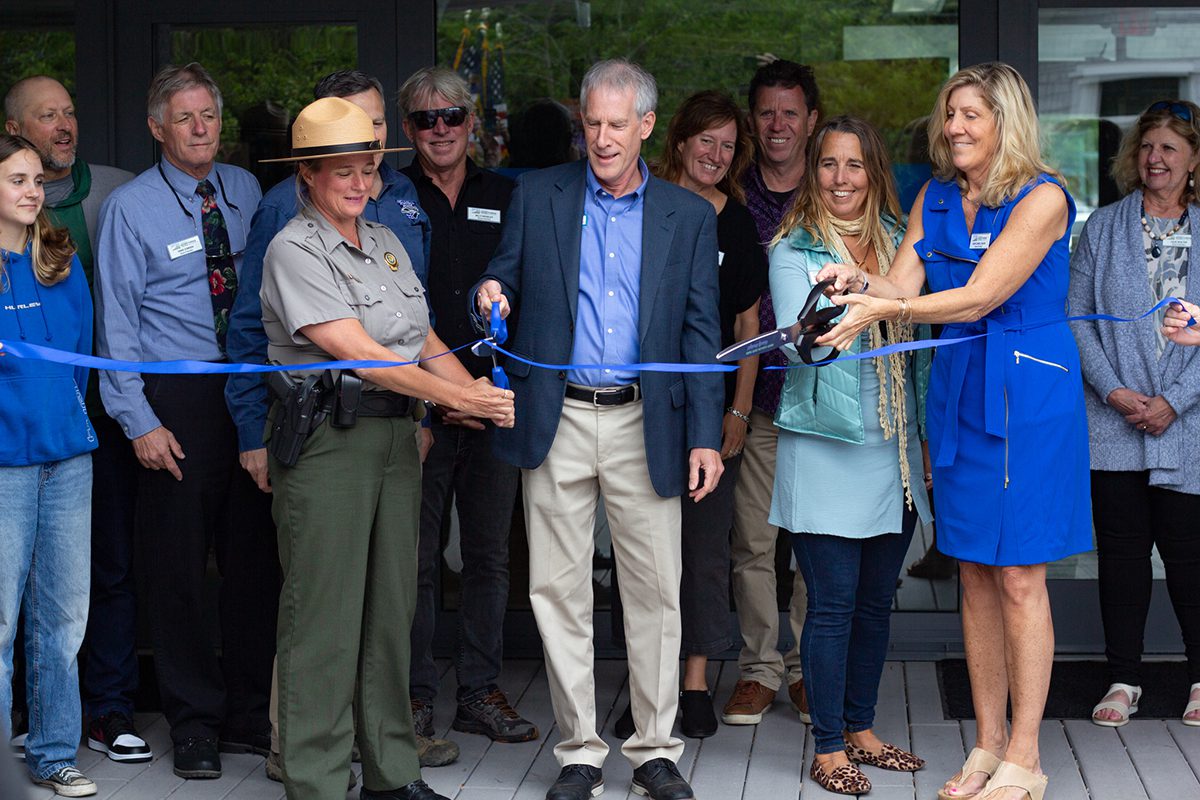
NAGS HEAD — Officials last week celebrated the newly renovated visitor center at Jockey’s Ridge State Park, marking the completion of a $2 million project that ran about a year behind schedule.
State officials from Raleigh, as well as local government representatives, park staff and members of the nonprofit Friends of Jockey’s Ridge, which supports the park, were on hand May 25 for the ribbon-cutting ceremony on the visitor center’s back deck.
Supporter Spotlight
It was an unusually cool and blustery day for late May, courtesy of a coastal low swirling in the Atlantic Ocean. The weather underscored the importance of the project. Several who spoke told the crowd of more than 90 that the expanded and upgraded visitor center provides an educational atmosphere in which visitors can also briefly escape the Outer Banks’ sometimes harsh elements.
The 426-acre state park, situated on a thin strip of sand between the ocean and the Roanoke Sound, contains the tallest living sand dune system on the East Coast.
“This is already such an iconic park,” said D. Reid Wilson, secretary of the North Carolina Department of Natural and Cultural Resources. “People, if you mention Jockey’s Ridge, go, ‘Oh yeah, I love it.’ Everybody has stories about this amazing place.”
Wilson continued, “But now the visitor experience will be even better. People will be able to come in here, get out of the sun a little bit, get out of the wind, and learn a lot more than they could before in just a beautiful, beautiful facility. So, congratulations to all who made that happen.”
The $2,048,463 project began in June 2021, with an expected completion date of April 2022. The work, which included renovating the building’s lobby, exhibit hall and meeting room, as well as installing electric vehicle chargers in the parking area, was just finished in April this year.
Supporter Spotlight
Park Superintendent Joy Greenwood said the delay was partly because of having to wait on federal flood maps to be approved and because of materials supply chain issues.
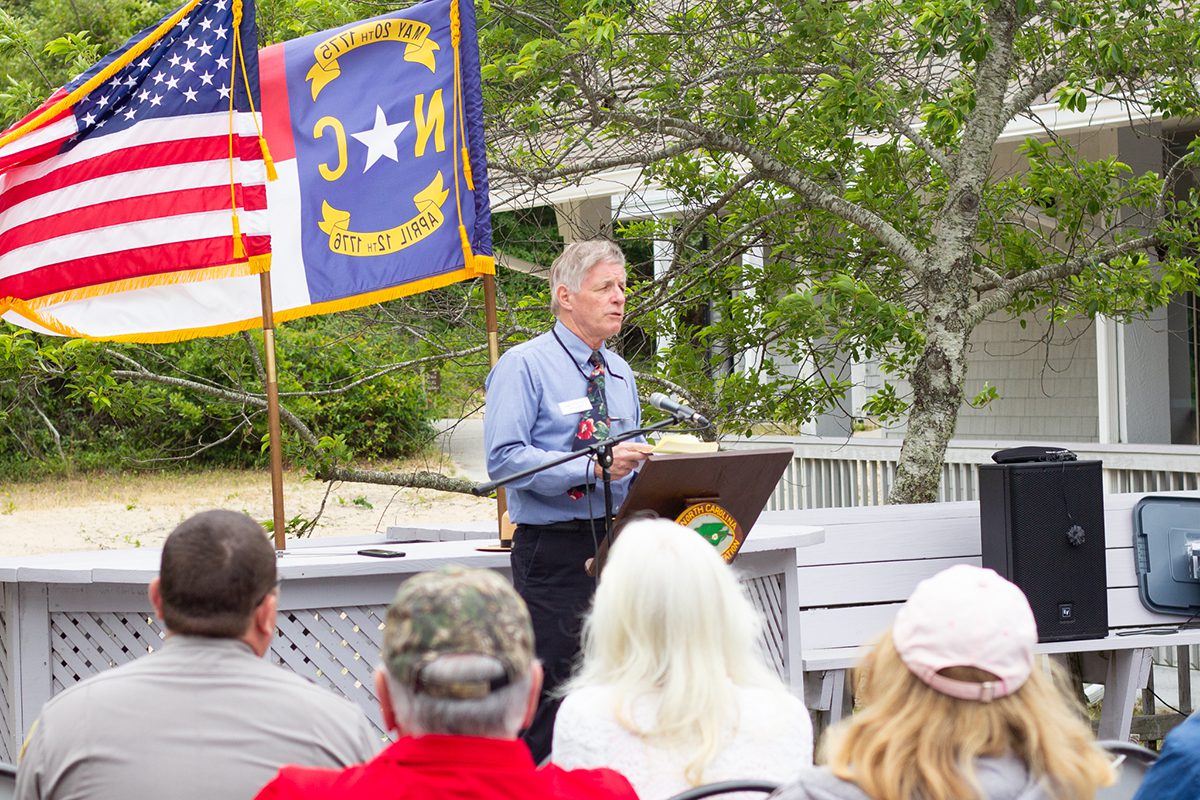
Jockey’s Ridge State Park boasts the second state park visitor center to be built in North Carolina, but the structure had not been updated in any major way since its completion in 1998, she said.
Officials said the renovation improved the flow of foot traffic throughout the visitor center and added 1,000 square feet of space. “The lobby is twice as big as it was originally,” Greenwood said, describing how cramped people had been in both the lobby and in the exhibit hall before.
The exhibit hall “has totally been gutted and redone,” she added. The educational exhibits hadn’t been upgraded since around 2002.
“There was an exhibit on hurricanes, and the last one on the list was in 2001,” she said. “The exhibits were so old and people had touched them so much that the writing had worn off.”
The meeting room similarly underwent a conversion into a more open, better lit, “usable space,” she said. Before, it was an infrequently used dark room with a heavy, wooden door.
Connect NC bond funding, which state voters approved in 2016, paid for most of the project, with supplemental funding from the state Parks and Recreation Trust Fund.
“Every park has a new facility or a new land acquisition that was started in 2016 with the Connect NC bond,” Brian Strong, interim director of the North Carolina Division of Parks and Recreation, said during the ceremony.
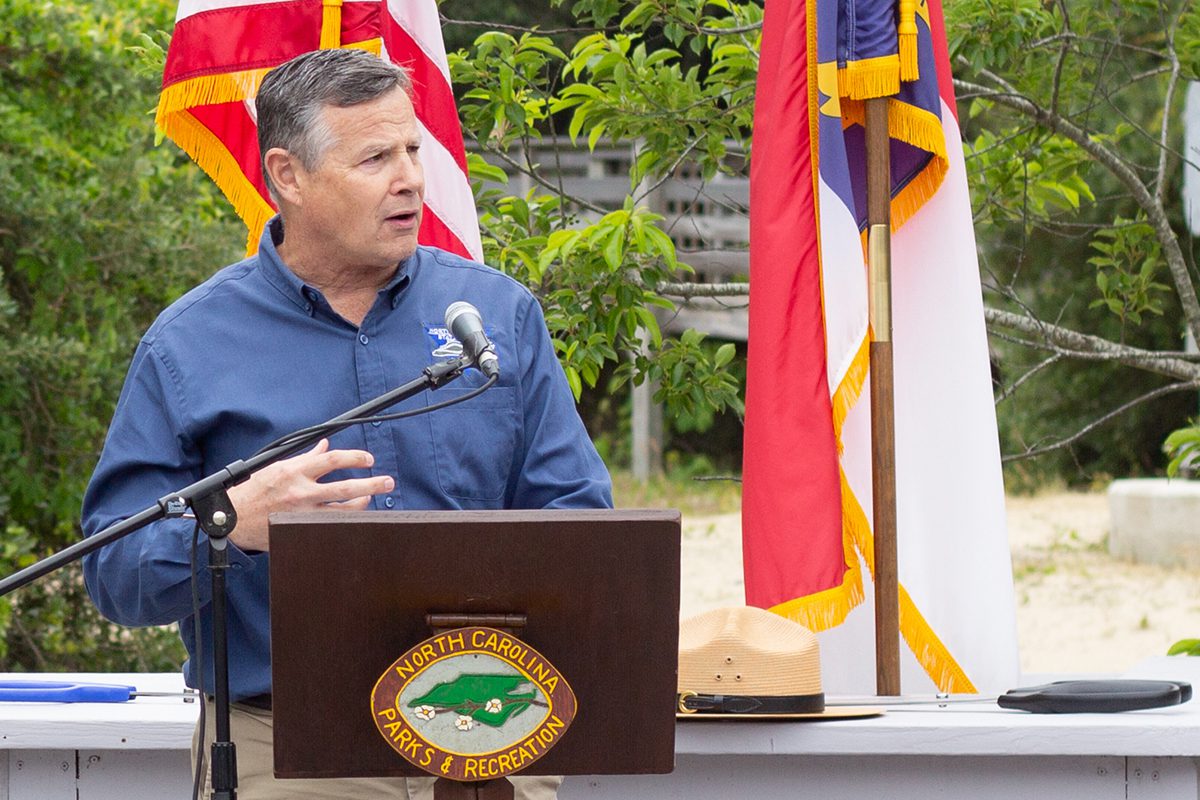
Jockey’s Ridge was the most-visited state park in 2021, with 1.8 million visitors, and it consistently ranks as one of the most-visited North Carolina parks.
“We get well over a million people here every year, and I’m excited that these new facilities will really help to enhance those visits, (and) help people to understand how important this natural resource is,” Strong said.
Strong thanked the Friends of Jockey’s Ridge “for all of the hard work you guys have done; you have put in some amazing hours.” He also thanked members for their advocacy on behalf of the park, both within the community and to elected officials.
The nonprofit was founded in 1990, explained Mike O’Brien, Friends of Jockey’s Ridge board chair, during his remarks. “Our mission is tosupport, enhance and promote Jockey’s Ridge as a significant geological feature on the Outer Banks of North Carolina.”
Led by Executive Director Robin Hallac, the Friends of Jockey’s Ridge acquired a tourism grant for a utility terrain vehicle, or UTV, for the park, which has provided 125 dune rides to 341 individuals so far for this year, O’Brien said.
The nonprofit’s work today continues efforts that began with the Junior Friends of Jockey’s Ridge: “The first budget was a brochure written by children for children,” O’Brien said, noting that their second project was creating “Tracks in the Sand,” a trail to the sound that still exists. “Then they built the boardwalk, which we still have today.”
George Barnes, the first superintendent for Jockey’s Ridge State Park, is a longtime Friends board member who said he helped shape the organization. In his 32 years as superintendent, “I saw a lot of things that we needed to do and we couldn’t get money for it, like that boardwalk out there,” Barnes said at the reception following the ribbon cutting.
The Junior Friends of Jockey’s Ridge and the newly formed adult Friends contingent, along with two area contractors who donated their time, built the 340-foot boardwalk with lumber donated from lumber companies, Barnes recalled. Even some visitors who were passing by and asking what was happening ended up lending a hand and helping build part of it.
Everyone’s efforts about 30 years ago resulted in a more accessible way for more people to enjoy the park to this day — “and it didn’t cost the state one dime.”
Barnes was enthusiastic about the renovation and said he thought children would be, too.
“We used to have like a little magnifying glass (through which) you could look at a grain of sand and see it. They’ve got this thing now where you can look at it and blow it up on that big screen,” he said, gesturing toward a microscope focused on grains of sand by a projection screen in the community room.
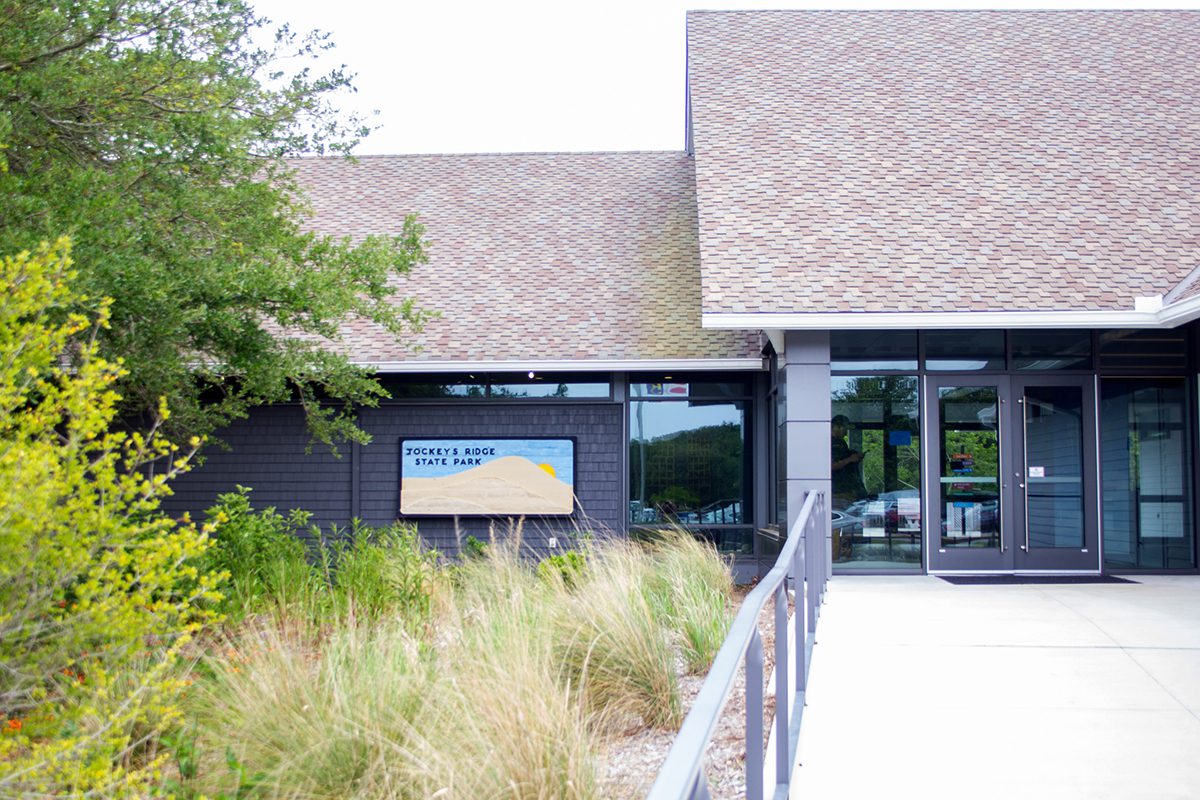
“Kids see that kind of stuff and think, ‘That’s what we’re here for,’” he continued. “Let them learn about what it is here, and why it’s here, and why it stays and why it moves away. It’s a living sand dune.”
Tim Rayworth, an interpretive designer for North Carolina State Parks, chatted with guests in the community room during the reception. He and other staff began work on the new exhibits over four years ago.
“We started by working with the staff and talking about what important stories were here, and then distilling that down into a few big ideas,” Rayworth said.
Those “big ideas” included the park’s three habitats: the dunes, the maritime forest and the estuary, “because that’s often overlooked.”
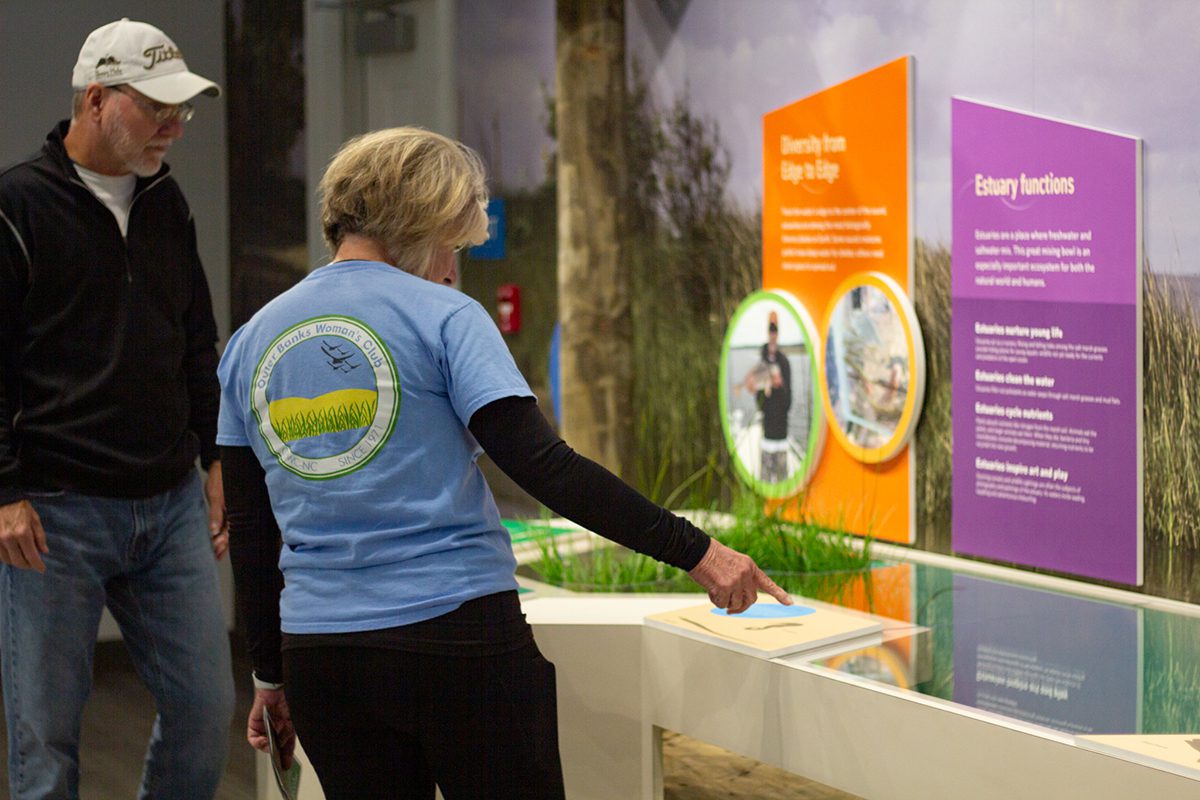
The new educational exhibits “spilled into the lobby” as the park’s origin story of concerned residents banding together, raising money and lobbying the state became a feature in the lobby.
“We’ve got some parks that have really interesting stories,” he opined. “This is among one of the more interesting ones. It was really a grassroots thing … the community rose to bring it together.”
The first state park, Mount Mitchell, was created in 1915. “There’s really nobody around anymore” who could share firsthand accounts of that or of other early state parks.
But crafting the exhibit about the efforts that led to the 1975 establishment of Jockey’s Ridge State Park underscored a difference.
“Here, it’s not history,” Rayworth said. “It’s living memory for a lot of people.”
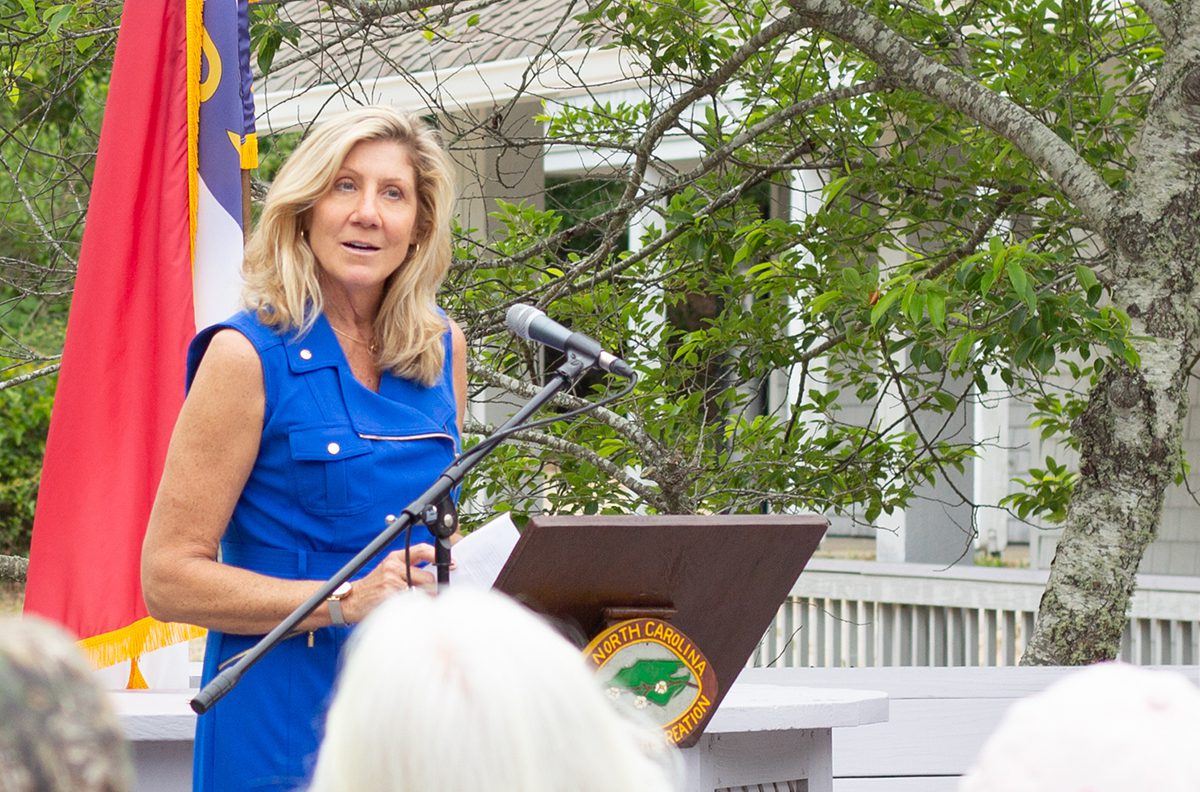
For Ann-Cabell Baum, whose mother Carolista Baum famously initiated actions to preserve the dunes, it’s an indelible part of her childhood.
During her remarks at the ceremony, Ann-Cabell Baum recalled playing on the sand dunes every day during the summer with her two younger siblings. “One afternoon, we were coming back across and there was a bulldozer. And then guess what? We ran home and told our mom.” She’d promptly marched over to confront the driver, who stopped.
“I would have stopped too,” Baum quipped. “If you knew my mom, you would have done what she said. And later that evening, she went back and took the distributor cap off so they could not complete the work.”
Baum thanked everyone “for the hard work that’s gone into this gorgeous building.” She also shared a reminder: “We have an incredible legacy with this natural resource behind us, and … it’s our responsibility every day to make sure that it is here for generations to come.”
Just last fall, Baum followed in her mother’s footsteps and spearheaded efforts to that effect when a section of the park was threatened with potential development. Plans surfaced of a private, for-profit museum that was proposed to be built on park land with a free 99-year lease. Baum crafted a petition, collected more than 2,500 signatures and, along with the Friends, shared concerns with state and local officials. State officials in late October decided to decline to lease the land.
In an interview during the reception, Wilson appeared to give a nod to those events.
“It’s just a really special place, and when you consider how hard the Friends of Jockey’s Ridge works to support this park, you realize how invested the community is in its success,” he said. “These are tenacious people.”
For her part, also at the reception, Baum said that members of the Friends “are awesome. They really dug in, and when they needed to be there, they were there and made things happen. And reminded everybody why we all love this place.”
She added, “It’s my favorite place on Earth.”







